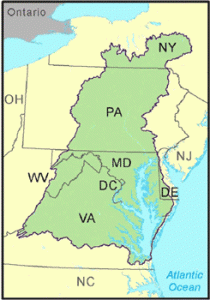
By the end of 2018, the Commonwealth is required to submit to the Environmental Protection Agency (EPA) its final “Phase 3” Chesapeake Bay Watershed Implementation Plan (WIP). The WIP’s chief purpose will be to lay out a strategy for Virginia to implement all measures necessary to meet specific pollution reduction goals for the Chesapeake Bay by the year 2025. Local governments will largely be responsible for upgrading stormwater management systems, installing nitrogen reduction technologies in wastewater treatment plants and encouraging the agricultural community to participate in cost share programs to finance Best Management Practices (BMPs) to effectively reduce runoff of excess nutrients and sediments from farms.
Reductions in loadings of nitrogen, phosphorous and sediments into the Bay of 8 percent, 20 percent and 7 percent, respectively, have been achieved between 2009 and 2015, according to officials from the Chesapeake Bay Program. In 2009, the Executive Order was issued to establish the so-called Chesapeake Bay “pollution diet” that incorporated specific water quality goals that need to be met by 2025. To achieve these reductions local governments, with financial assistance from the General Assembly, have made major investments to improve the water quality throughout Virginia. However, by 2025 there are many more water quality improvements the EPA will expect Chesapeake watershed jurisdictions to achieve.
Virginia’s Chesapeake Bay Stakeholder Advisory Group (SAG) is comprised of diverse representatives from industry, agriculture, environmental organizations and local governments.
At the SAG’s May 3 meeting, its members were informed by the McAuliffe Administration of plans for developing the Phase 3 WIP. Over the next year, much of the preliminary work will be technical in nature with a particular focus on improving the accuracy of land use information for the portion of Virginia that falls within the Chesapeake Bay watershed, approximately 60 percent of the state’s land mass. Tools that should be available in these efforts will be higher resolution mapping technologies. Improved accuracy pertaining to land use throughout the watershed will be a significant part of improving the computer model EPA uses to determine water quality improvement targets and the land-based measures necessary to achieve them.
EPA is also considering the possibility of establishing pollution reduction “targets” that would apply to certain designated areas. For local governments, the establishment of area “targets” could be extremely significant, which is why EPA is convening a work group that will meet over the next year. This work group will be comprised of local government representatives from all Bay states, which are New York, Pennsylvania, Delaware, Maryland, West Virginia, and Maryland. The District of Columbia will also be included.
The Chesapeake Bay midpoint assessment was extensively discussed during a meeting that took place last March by the Chesapeake Bay Program’s Local Government Advisory Committee (LGAC). Virginia county representatives on LGAC are VACo’s Immediate Past President Penny Gross, King George County Board Chair Ruby Brabo and VACo staff member Larry Land. All Virginia LGAC members agree that over the next few years, outreach to, and participation of, local government officials will be critical as the Virginia’s Phase 3 WIP is developed. In many different ways, VACo plans to be very active during this process.
For further information about the Chesapeake Bay midpoint assessment, please see this article that appeared the May 6 issue of “Bay Journal,” published by the Chesapeake Bay Alliance.
Sources: “Local Government Advisory Committee to help Localities Realize their Role in Restoring Watershed,” Bay Journal, May 6, 2016.
“Susquehanna Aside, Good News About Bay,” The Free Lance Star, May 11, 2016.
VACo Contact: Larry Land, CAE
